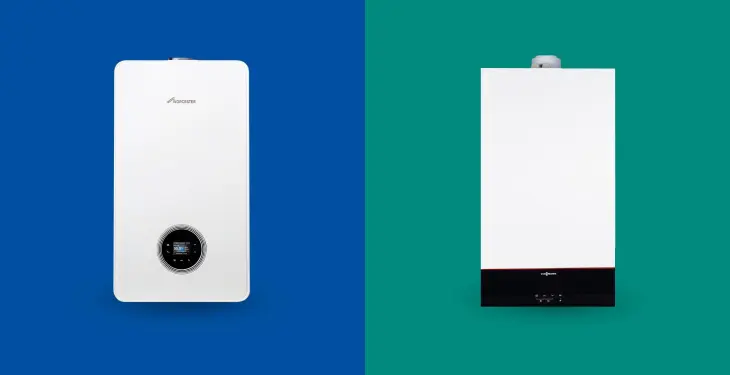

Written by Stephen Day
Gas Safe Engineer
Updated: 27th October, 2025
Should you replace that beaten up old back boiler and get with the times?
Get a new boiler quote, save up to £550 per year (0% APR available).
Back boilers have been a popular choice for homeowners in the UK since the 1960s, especially due to their space-saving design that fits behind a living room fireplace.
However, their popularity has diminished as more energy-efficient boilers hit the market.
It has been illegal to install a new non-condensing back boiler in the UK since 2005, when Building Regulations began requiring all new boilers to be high-efficiency condensing models. Existing back boilers can still be used if they are safe and maintained by a Gas Safe engineer.
Back boilers are quite an old type of boiler that fits behind an open fireplace rather than having its own cupboard or closed-off area.
Most of them were replaced in 2005 when the regulations around them changed, but there are still hundreds (if not thousands) in the UK that haven't been dealt with yet.
They may have been cheaper than normal boilers a few decades ago, but they are far more expensive to maintain nowadays.
The main difference between a back boiler and modern boilers is the way they work.
Most back boilers operate at around 70-80% efficiency when new, whereas modern condensing boilers can reach over 90%, meaning less wasted energy and lower running costs.
Back boilers are also hard to repair since they are not being made any more, and fresh parts are nearly impossible to find.
It is rare to find a back boiler that isn't behind a fireplace, making it hard to change where they are installed.
This might also mean that back boilers take up a lot of space if you are not using the fire, which means that you can often save space by removing the entire fireplace along with the back boiler. This will cost slightly more, though.
Back boilers are essentially cheaper and smaller boiler, at least by the standards of when they were created.
They were easy to buy and could be hidden behind your fireplace, which kept them out of the way and made them suitable for smaller homes.
As mentioned earlier, they were extremely inefficient but could last much longer before breaking, thanks to their simple design.
Unfortunately, since back boilers are almost impossible to repair easily, you will eventually have to replace or upgrade your existing boiler.
Even if it is still working, for now, the price and rarity of some key parts mean that it is probably just as expensive to repair as buying a new one, and there is no way to solve the efficiency problem without getting rid of the back boiler entirely.
If your house is new, it likely has no back boiler since its popularity dropped dramatically in the early 2000s.
Very few companies in the UK make them anymore, and it is tough to find brand-new back boilers anymore. Buying a new one is barely worth it anyway due to the massive efficiency problems they can have.
Back boilers only have one long-term upside: the small size.
The lower price doesn't matter anymore since they're more expensive to run and will probably cost you more than a regular design. The long operational life doesn't mean much, considering it is not easy to repair them.
The fact that they're kept out of the way also means that they can be hard to access without taking down parts of your fireplace, which can be annoying if something breaks or you want to make some small adjustments.
The size of a back boiler doesn't matter as much, either. Modern boilers are smaller than those from the last two or three decades, so it's not hard to find a regular boiler that is the same size as (or even smaller than) your old back boiler.
This will only affect people with a minimal amount of space in their homes, but even if that's the case, you can find compact designs that will still offer higher efficiency.
The higher efficiency makes a modern boiler far cheaper than a back boiler in the long run since you use less power to get the same results.
This can also help you get more consistent heat and provide better temperatures in general. Fixing a boiler isn't "cheap" in the usual sense, but it's still much less expensive than trying to repair a back boiler, and the money you save on your utility bills will make up for this.
Age of Boiler | Efficiency Percentage | Efficiency Rating (ErP) |
|---|---|---|
0+ Years | 90% + | A |
10+ Years | 85% + | B/C |
15+ Years | 80% + | C/D |
20+ Years | 70% + | E/F |
25+ Years | 60% + | G |
The correlation between a boiler's age and efficiency is clear in the newer ERP systems.
Regardless of what your old back boiler model was, most people will choose a new combi boiler as a replacement since they are some of the most efficient and reliable models available to the general public.
These are also the most likely to work with your existing central heating system, so you generally won't need to swap out anything except the boiler itself.
Get a quote in 60 seconds, fitted as fast as next day!
0% APR finance available.
Different boiler designs will have their price differences, especially if you have to change more than just the boiler you use.
The average cost of replacing a back boiler with a modern combi or system boiler is usually between £3,000 and £5,000, depending on boiler type, pipework, and whether the new boiler is relocated.
Always make sure any engineer working on your back boiler is Gas Safe registered
If you're interested in a new combi boiler then we have a HUGE guide on finding the best combi boilers in 2025.
This cost of replacing a back boiler includes things like:
Pipe capping
The installation of new pipes
Upgrades to parts of your central heating
Removal of old back boiler
If your boiler is going to be in a different part of the house, you'll have to pay for the pipe involved and the existing pipe that needs to be blocked up to stop leaks.
Some people prefer to go the "system upgrade" route, replacing the boiler but keeping the rest of the heating setup the same.
This can be a cheaper option since it involves minimal pipework, but it won't always be an option depending on the size and type of your new boiler.
On the other hand, some people want to redo the entire system to ensure it is completely fresh, reducing the chance of older parts breaking down or wearing out.
Costs aren't always set in stone, so you never know when your price might increase or decrease based on different options and situations.
Some houses might make setting up a new boiler far more expensive due to the thickness of their walls or the way the central heating system is set up. If you're looking into back boiler replacement, get a quote or estimate first.
Replacing your boiler isn't too difficult, even if you do it yourself. As long as you understand the specifics of back boiler replacement, swapping them out doesn't take long.
New boilers need a flue or some way to ventilate gases, ideally one that won't reduce its efficiency too much. Back boilers will vent these gases directly up the chimney, whereas a combi boiler can vent in horizontal and vertical directions.
This often means that you'll need to set things up differently, but it's sometimes possible to keep a similar flue and have it vent out of the chimney similarly.
Many combi boilers can fit inside small spaces, like cupboards, so it is often possible to fit them in the same space as your older back boiler. They might also work in a kitchen cupboard, under-the-stairs area or behind an interior wall.
If you want to move your boiler to a new area, you'll need to pay slightly more for the extra work, especially if there are no pipes there already.
This can cost anywhere from £300 to as high as £600 on average, or more if you have a larger house that needs more piping. You'll still usually be able to tie it into the existing central heating system, which can save some money on the installation.
As soon as you have the time and money to replace it, you should try and get it done since the higher efficiency will save more money. However, the fact that back boilers are long-lasting means that you don't necessarily have to swap them out immediately if you don't need to.
They'll break less often than a combi boiler, which can save some money if you're fortunate.
If your back boiler breaks to the point where you need to perform major repairs, you may as well get it replaced. It'll probably cost around the same amount in the long term, and it gives you a good opportunity to install a new boiler now that you've got a solid excuse.
One advantage of having a back boiler is that it doesn't take up much space in your room as it is located behind the fire.
They are also quite easy to install, and you can usually find someone who knows how to do it without too much trouble.
In addition, back boilers can be used to heat more than one room in your house as they circulate hot water through a wet central heating system.
Finally, if you have a gas-fired back boiler, you can use the heat from the fire to cook your food!
One disadvantage is that they can be quite expensive to run as you need to keep the fire going to generate heat.
In addition, if the fire goes out, you will need to wait for it to cool down before you can restart it, which can be quite annoying!
Finally, if you have a gas-fired back boiler, it is important to remember that they require regular servicing and maintenance to stay safe and efficient
Some back boiler models are cheaper to repair than others, depending on who made them and the parts they use, so it's not always a terrible idea to keep yours around for a while longer. However, it's still far more expensive overall, especially due to the massive drop in efficiency that'll increase your bill prices by quite a large amount.
Always choose a new boiler you can rely on. Not all modern boilers are perfect, so if you're upgrading, you'll want to ensure you've gotten one that works well. A higher-quality boiler might cost slightly more, but you'll save plenty of money, which makes it a great trade-off.
When you replace your old back boiler, you must work out what to do with the old boiler and set up a new replacement combi boiler.
There are two main options: you can have your old boiler removed, clearing out the space and having it taken away, or you can simply have it decommissioned instead.
This means that it will be switched off and made safe, and then left in place exactly where it is, with no need to hire anyone to take it away.
So, what exactly is in this decision? Well, the first thing to bear in mind is cost. Having your back boiler decommissioned and left in place could save you up to £1000 from your full boiler replacement bill, which is potentially worthwhile!
If you plan on paying for your new boiler on finance rather than upfront, though, then this sort of saving might not have much of an impact on the size of your monthly repayments. If you are paying upfront, however, £1000 off your bill is worth considering!
It is worth noting that even if you opt to decommission your back boiler, engineers will still need to get behind your fireplace to access the boiler properly.
That means you will probably still need to do some repair work afterwards, including things like replacing some of the surrounding flooring and potentially making repairs to your fire mantle or even replacing it completely.
Not every boiler can be safely decommissioned. Before deciding whether to decommission or remove your back boiler, you should call a gas-safe engineer to inspect it first.
If your gas-safe engineer declares your boiler safe to decommission without removing it, then the choice is entirely up to you. If your boiler is declared unsafe to decommission, the decision is out of your hands, and you must have the boiler obliterated.
Replacing a back boiler in the UK can be costly, but various grants and finance options can help homeowners save money.
Homeowners can significantly save on energy bills by upgrading to a more energy-efficient boiler. Modern boilers are designed to be more efficient than older back boilers, reducing carbon emissions and monthly heating bills.
Financial support is available to help ease the burden of back boiler replacement costs. Removal grants, for example, can provide 100% funding for back boiler removal and installation of a more efficient heating system.
The amount of funding varies according to one's location, individual circumstances, and property.
Another option to explore is the Boiler Upgrade Scheme. This UK government initiative offers grants to cover part of the cost of replacing fossil fuel heating systems with a heat pump or biomass boiler. Eligibility for the scheme depends on various factors, including income, household circumstances, and geographical location.
To ensure getting the best deal on boiler replacements, homeowners should obtain comparison quotes from Gas Safe registered heating engineers in their area. This will enable them to consider various cost-effective options and make an informed decision.
In summary, while back boiler replacement costs may seem initially steep, the long-term savings on energy bills, coupled with available grants and finance options, present valuable opportunities for UK homeowners seeking a more energy-efficient and cost-effective heating solution.
When discussing back boiler replacement, it's crucial to comprehend the concept of boiler efficiency. Boiler efficiency plays a significant role in determining energy efficiency, which directly impacts energy consumption and costs.
To gauge boiler efficiency, energy efficiency ratings are used. An understanding of these efficiency ratings can help homeowners make well-informed decisions about boiler replacements.
Boiler efficiency is a measure of how well a boiler converts fuel into heat. The higher the efficiency, the less fuel is required to generate the same amount of heat.
Modern boilers tend to have higher efficiency ratings, translating to increased energy efficiency and reduced energy bills.
In contrast, back boilers, which were popular in the 1960s and 1970s, are often plagued by poor energy efficiency, rendering them less desirable in today's eco-conscious world.
Energy efficiency ratings provide an easy-to-understand metric that allows homeowners to compare different boilers.
The UK employs the ErP (Energy-related Products) directive, which assigns efficiency ratings ranging from A+++ to G.
An A-rated gas boiler typically achieves efficiencies above 90%. Heat pumps, by comparison, can achieve the equivalent of 200-400% efficiency (known as a COP of 2-4) because they move heat rather than generate it.
Sure, you could install a new boiler without getting rid of your old back boiler, but there are safety risks with that option that can create major problems.
If you have an old, unused back boiler in your house that has not been properly decommissioned, it can present a major safety hazard that should not be overlooked.
An unused back boiler is still full of water, which can stagnate and create health hazards or can cause major issues with your heating system.
A large body of water such as this can build up pressure when the rest of your heating system is activated and starts to warm up. If this is not properly cut off from the rest of your heating system, the water in your old back boiler can build up a lot of pressure and cause leaks or even explosions.
References
Energy Saving Trust - https://energysavingtrust.org.uk/
Gas Safe Register - https://www.gassaferegister.co.uk/
Boiler Upgrade Scheme (GOV.UK) - https://www.gov.uk/apply-boiler-upgrade-scheme
Based on data from over 72 back boiler replacements completed by iHeat in 2024, the average energy saving from upgrading to an A-rated condensing boiler was around 20–25% on annual heating bills.*
No, you can’t install a new back boiler in the UK. They were banned in 2005 because of safety and efficiency issues.
Last updated: 27th October, 2025

Written by Stephen Day
Gas Safe Engineer at iHeat
Stephen Day is a Gas Safe registered and FGAS certified engineer with over 20 years of hands-on experience in the heating, cooling, and renewable energy industry, specialising in boiler installations, air conditioning, and heat pump systems.
LinkedInArticles by Stephen Day are reviewed by iHeat’s technical team to ensure accuracy and reliability.

28th November, 2025
A clear comparison of Worcester Bosch and Vaillant Boilers and why Worcester Bosch is ofte...
 Read Article
Read Article

27th November, 2025
Maintaining a boiler in good working order is essential for its efficiency and longevity....
 Read Article
Read Article

27th November, 2025
Most Hive heating issues come from lost connection, low batteries, receiver faults or boil...
 Read Article
Read Article
No obligation. Takes less than 60 seconds.